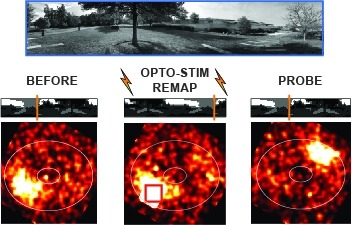Filter
Associated Lab
Associated Support Team
3 Janelia Publications
Showing 1-3 of 3 resultsIn flies, the direction of moving ON and OFF features is computed separately. T4 (ON) and T5 (OFF) are the first neurons in their respective pathways to extract a directionally selective response from their non-selective inputs. Our recent study of T4 found that the integration of offset depolarizing and hyperpolarizing inputs is critical for the generation of directional selectivity. However, T5s lack small-field inhibitory inputs, suggesting they may use a different mechanism. Here we used whole-cell recordings of T5 neurons and found a similar receptive field structure: fast depolarization and persistent, spatially offset hyperpolarization. By assaying pairwise interactions of local stimulation across the receptive field, we found no amplifying responses, only suppressive responses to the non-preferred motion direction. We then evaluated passive, biophysical models and found that a model using direct inhibition, but not the removal of excitation, can accurately predict T5 responses to a range of moving stimuli.
Many animals rely on an internal heading representation when navigating in varied environments. How this representation is linked to the sensory cues that define different surroundings is unclear. In the fly brain, heading is represented by 'compass' neurons that innervate a ring-shaped structure known as the ellipsoid body. Each compass neuron receives inputs from 'ring' neurons that are selective for particular visual features; this combination provides an ideal substrate for the extraction of directional information from a visual scene. Here we combine two-photon calcium imaging and optogenetics in tethered flying flies with circuit modelling, and show how the correlated activity of compass and visual neurons drives plasticity, which flexibly transforms two-dimensional visual cues into a stable heading representation. We also describe how this plasticity enables the fly to convert a partial heading representation, established from orienting within part of a novel setting, into a complete heading representation. Our results provide mechanistic insight into the memory-related computations that are essential for flexible navigation in varied surroundings.
Short-term memories link events separated in time, such as past sensation and future actions. Short-term memories are correlated with slow neural dynamics, including selective persistent activity, which can be maintained over seconds. In a delayed response task that requires short-term memory, neurons in the mouse anterior lateral motor cortex (ALM) show persistent activity that instructs future actions. To determine the principles that underlie this persistent activity, here we combined intracellular and extracellular electrophysiology with optogenetic perturbations and network modelling. We show that during the delay epoch, the activity of ALM neurons moved towards discrete end points that correspond to specific movement directions. These end points were robust to transient shifts in ALM activity caused by optogenetic perturbations. Perturbations occasionally switched the population dynamics to the other end point, followed by incorrect actions. Our results show that discrete attractor dynamics underlie short-term memory related to motor planning.

